Original URL: https://www.theregister.com/2007/06/05/review_intel_v8_qx6800/
Intel power PC platforms: Core 2 Extreme QX6800 and V8
Blistering performance?
Posted in Personal Tech, 5th June 2007 11:02 GMT
Review Intel has been dancing all over AMD's financials with its Core 2 processors for the past year and it's keeping up the pressure, most recently with the Core 2 Extreme QX6800 and, more intriguingly, it's product-that-isn't-a-product, the V8 platform.
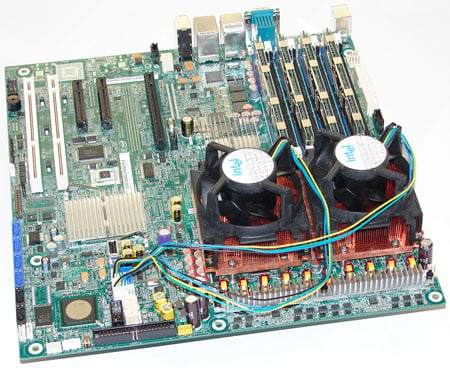
Intel's V8: firing on all cylinders?
Let's start with V8 as it's something of an odd ball. It consists of an Intel S5000XVN ATX motherboard and two quad-core Xeon X5365 processors, each clocked to 3GHz and capable of operating on a 1333MHz frontside bus. With it, Intel sent us a pair of CPU coolers, 4GB of Samsung FB-DIMM PC2-5300F memory and an 850W power supply from Cooler Master.
So, that's eight physical cores on two sockets all with an estimated value of £2400. Good value as a bundle? It's hard to be sure, as Intel isn't selling the V8 as a system but is instead touting it as a technology showcase.
Or is it? As it happens the Xeon X5365 processor isn't currently available through the usual channels. If you want one, you have to buy a Mac Pro from Apple. The covering letter that came with the V8 refers to an "eight-core media creation PC", which is a pretty good description of the top-of-the-range Mac Pro.
Could V8, or a version of it, be a board supplied by Intel for Apple and now getting a lease of life beyond the Mac platform? Neither Intel nor Apple are saying, of course.
To try it out, we plugged in a Western Digital WD150 Raptor hard drive and an Asus GeForce 7950 GT graphics card and then tried to install the 64-bit version of Windows XP 64-bit - 32-bit XP isn't supported by this hardware. Two things manifested themselves. First, there's a delay of 30 seconds or more between power-on and POST. It takes so long to get to this stage that we started to wonder if the kit was broken. Secondly, the 64-bit XP installer wouldn't recognise any SATA hard drive that we had to hand, so we plumped instead for installing the 32-bit Windows Vista Ultimate and all was well.
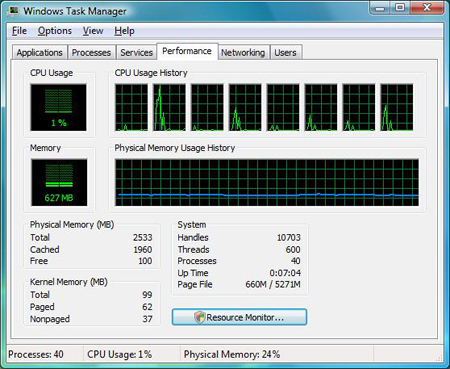
Intel's V8: eight cores in action
We ran a series of tests on the V8 which consisted of PCMark05, encoding a 350MB AVI file to DVD with Nero 7, and finishing up with POV-Ray. Glance at the results and you'll see that V8 is fast in PCMark05 and Nero but not much faster than the QX6800. You'll find the charts on the next few pages. POV-Ray is a different story as it is properly threaded to use multi-core processors, and in this test V8 delivers huge performance but, let's face it, that's not much use unless you are rendering the next Pixar movie at home.
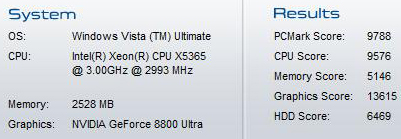
Intel's V8: scoring well in PCMark05
You'll also note that the power draw of V8 is huge, to the extent that the motherboard requires a power supply with the usual 24-pin connector, as well as both 8-pin and 4-pin plugs. You also need a case fan solely to keep the FB-DIMM memory cool.
In other words, this hardware is ideally suited for a workstation rather than a PC, so what on Earth is Intel playing at by sending this hardware to Register Hardware?
The likeliest explanation is that Intel wants to show the CPU part of its 'Skulltrail' platform to the world. This is the platform that will combine dual quad-core CPUs with four PCI Express x16 slots to deliver a humungous gaming system, although you have to wonder about the graphics side of things. Will Skulltrail support CrossFire, and will SLI support Skulltrail? If not you certainly won't need four long PCIe slots and may not even require two.
Next we come to the Core 2 Extreme QX6800 which is a speed bump of the QX6700, so it runs on a 1066MHz FSB, is made using a 65nm process and has 8MB of L2 cache. Where the QX6700 delivered 2.67GHz by running at 10x 266MHz, the QX6800 has an 11x multiplier and a speed of 2.93GHz. The TDP is raised from 130W for the QX6700 to 150W with the QX6800, while the price has increased to a scary £810.
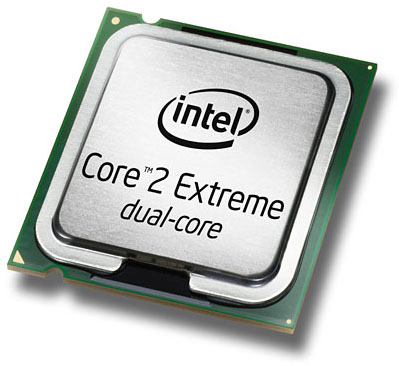
We tested a bunch of LGA775 processors on an MSI P35 Platinum motherboard with 2GB of Kingston KHX6400 memory, an Asus EB7950GT graphics card and a WD150 Raptor hard drive, all running on Windows XP Pro SP2.
PCMark05 tests
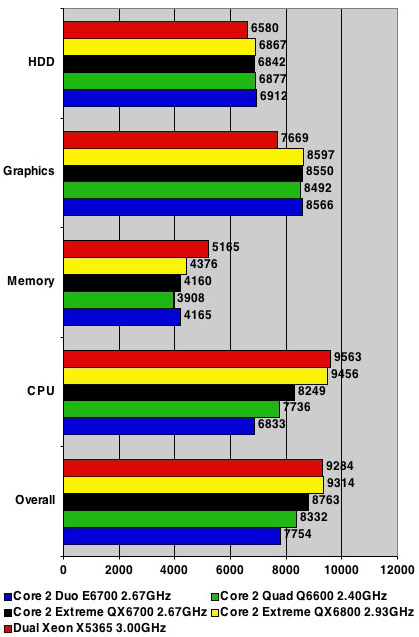
Longer bars are better
The dual-core E6700 did surprisingly well in PCMark05 and Nero and the lower clocked but four-cour Q6600 took longer in our Nero test, which confirms that two cores are enough for most of the software that is available today. Once again, POV-Ray showed the benefits that we'll get from quad-core when software takes advantage of this feature.
Processing speed tests
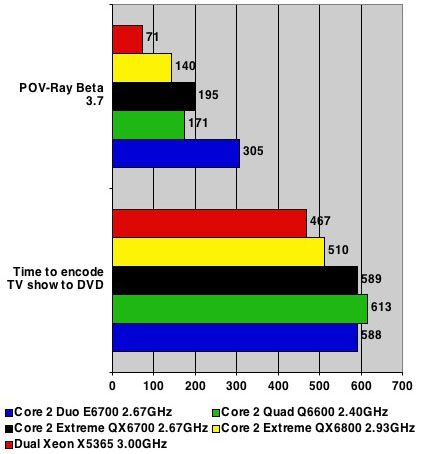
Time in seconds - shorter bars are better
We got some funny results from the QX6700. It was slower than the Q6600 in POV-Ray, which is inexplicable, and the power draw was higher than we had expected.
And so we plugged in the QX6800 and were pleasantly surprised to see that performance scaled with clock speed, exactly as you'd hope, while the power requirement was modest compared to our QX6700.
Processor thermal tests
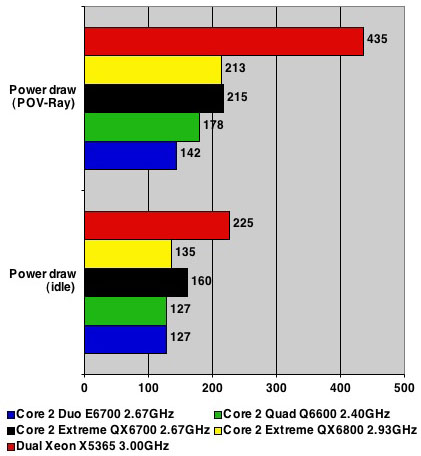
Power draw in Watts - shorter bars are better
Add those results together and we can conclude that Intel has speed binned the very fastest Core 2 parts that it can find to deliver a final hurrah before it moves on to the 45nm next-gen 'Penryn' toward the end of the year. Quite possibly, Intel doesn't especially want you to buy a QX6800, it just wants to show you what an enormous advantage it has over AMD.
Verdict
Both V8 and the QX6800 are monstrously powerful, in every sense of the word. The eight cores of V8 are fun but purists will doubtless point out that it's actually four dual-core processors on two sockets. No matter how you look at it V8 and Skulltrail will require a considerable amount of input from the software developers to get the most out of four, eight and more cores.
As for Core 2 Extreme QX6800, it's darned impressive but also absurdly expensive.